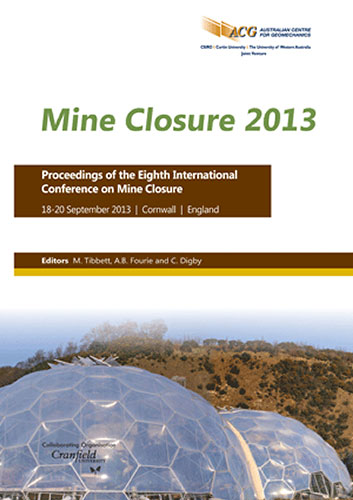Coal mine methane management, Nord-Pas-de-Calais, France

|
Authors: Défossez, P; Lemal, S; Schumacher, J-P Paper is not available for download Contact Us |
DOI https://doi.org/10.36487/ACG_rep/1352_50_Defossez
Cite As:
Défossez, P, Lemal, S & Schumacher, J-P 2013, 'Coal mine methane management, Nord-Pas-de-Calais, France', in M Tibbett, AB Fourie & C Digby (eds), Mine Closure 2013: Proceedings of the Eighth International Seminar on Mine Closure, Australian Centre for Geomechanics, Cornwall, pp. 597-609, https://doi.org/10.36487/ACG_rep/1352_50_Defossez
Abstract:
A coal mine, once closed, still ‘lives’. Coal beds release methane, which is then trapped in the mine voids by water rising as a result of natural flooding. The consequence is a rise of pressure (a well-known phenomenon in every coalfield), which may be dangerous because gas can migrate directly to the surface. Controlling mine gas risk is essential for safety reasons, due to methane’s highly flammable nature. A control methodology was developed by the original operator, and starting on this basis, geological studies and probability calculations conducted by the BRGM in several French coalfields in the past are today key to improve control. Methane is bonded on both the internal and the external surfaces of each particle of coal, due to numerous cracks. Gas is released by desorption under specific pressure conditions, defined for each coal by isotherm curves. Desorption occurs naturally into the atmosphere above atmospheric pressure, but gas can also be released beneath by pumping. A whole mine can sometimes turn into a methane reservoir. The definition of risk is then based on two concepts. For ground gas migration, risk is theoretically defined as ‘a cross between the susceptibility of caprock to let methane pass and vulnerability at surface where it might meet sensitive elements such as habitats’. In this context, everything depends on the ground’s natural ability to allow migration. BRGM therefore carried out a geological study to identify ‘exhaust minimum requirements’ and determine where ground constitution, thickness or permeability is insufficient to contain the risk. BRGM then studied ‘the occurrence of the event’ pertaining to the mine shafts – i.e., the probability that the gas escapes through some works, and conducted preventative works. To this end, when mines were closed, a network of galleries was kept open to allow the gas to flow. In some cases, sealing works have been made, while in others, security structures were built before exploitation ended. Decompression boreholes are drilled above higher areas of the reservoir, allowing a ‘passive’ and continuous decompression. Finally, BRGM makes twice-yearly measurements of pressure, methane content and sealing. Meanwhile, GAZONOR, a company operating in the Nord-Pas-de-Calais since 1980, is dedicated to the research, extraction, purification and sale of coal mine methane extracted from the former coalfield. The original mission of GAZONOR meets justified and general interest needs of mine gas extraction. Indeed, methane extraction allows limiting potential risk of leaks and spontaneous or accidental explosions, while reducing greenhouse effect by preventing its free movement to the atmosphere. BRGM and GAZONOR certainly do not have the same goals, one working for people’s safety and the other for profit. However, both have the same study object and share a mutual interest in its understanding. In the end, whatever the vision of the reservoir, the purpose is to guarantee the sealing to control the risks while integrating economic and environmental issues.
References:
Becq-Giraudon, J.F. (1983) Synthèse structurale et paléogéographique du bassin houiller du Nord. Mém, BRGM, No. 123, 68 p.
Guise, Y. (2009) Instruction exutoires de gaz de mine 01/2009 – Analyse de risque et principes d’installation, Document BRGM, DPSM/DTAM/2009-082/CN-CV, 10 p.
Lemal, S. (2012) Clapets anti-retour, Courrier de l’UTAM Nord à l’intention de Monsieur Roger DHENAIN (DREAL NPC), DPSM/UTAM Nord/2012-627/SL, 1 p.
© Copyright 2025, Australian Centre for Geomechanics (ACG), The University of Western Australia. All rights reserved.
View copyright/legal information
Please direct any queries or error reports to repository-acg@uwa.edu.au
View copyright/legal information
Please direct any queries or error reports to repository-acg@uwa.edu.au